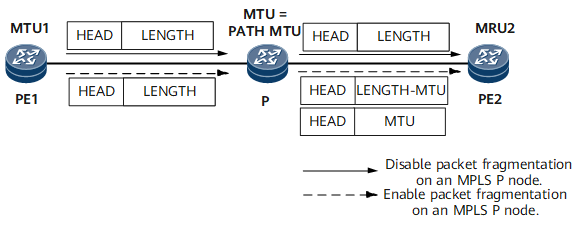MPLS P Fragmentation
Packet fragmentation enables an MPLS P node to fragment MPLS packets, which minimizes packet discarding during MPLS forwarding.
Background
A network with increasing scale and complexity allows for devices of various specifications. Without packet fragmentation enabled, an MPLS P node transparently transmits packets sent by the ingress PE to the egress PE. If the MTU configured on the ingress PE is greater than the MRU configured on the egress PE, the egress PE discards packets with sizes larger than the MRU.
Principles
In Figure 1, the ingress PE1 has MTU1 greater than MRU2 on the egress PE2. PE2 is enabled to discard packets with sizes larger than MRU2. Without packet fragmentation enabled, a P node transparently forwards a packet with a size of LENGTH (MTU1 > LENGTH > MRU2) to PE2. Since the packet length is greater than MRU2, PE2 discards the packet. After packet fragmentation is enabled on the P node, the P node fragments the same packet in to a packet with the size of MTU2 (MTU2 < MRU2) and a packet with a specified size (LENGTH minus MTU2). If the LENGTH-MTU2 value is greater than MTU2, the fragment is also fragmented. After the fragments reach PE2, PE2 properly forwards them because their lengths are less than MRU2.

Only IPv4 MPLS packets support P fragmentation.
MPLS MTU Calculation Method
Each LSR selects the smallest value among all MTU values advertised by preferred next-hop LSRs as well as the MTU of the local outbound interface mapped to a specified forwarding equivalence class (FEC) before advertising the selected MTU value to the upstream LSR. A downstream LSR selects an MTU value, adds it to the MTU TLV in a Label Mapping message, and sends the Label Mapping message upstream. If an MTU value changes (such as when the local outbound interface or its configuration changes), an LSR recalculates the MTU value and sends a Label Mapping message carrying the new MTU value to all upstream devices.
